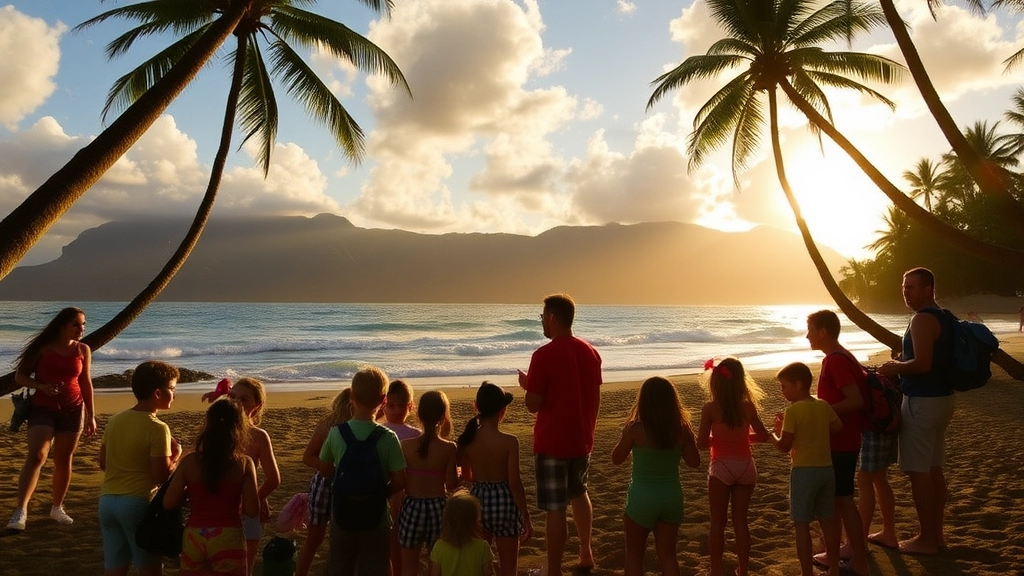Thinking About Sending Your Child to a Hawaii Summer Camp?
Excellent choice! Our article dives deep into everything you need to know, from the types of camps available and top locations, to the diverse activities offered and the incredible benefits your child will gain. We’ll also guide you through choosing the right camp, packing essentials, and the robust safety measures in place to ensure a worry-free experience.
What You Will Find in This Article
- Types of camps available
- Top locations
- Diverse activities offered
- Incredible benefits for your child
- Choosing the right camp
- Packing essentials
- Safety measures in place
Additional Information
But that’s not all. We’ve included testimonials from parents and campers, detailed the registration process and deadlines, and explored cost and financial aid options. Whether your child is into adventure, sports, arts, or STEM, there’s a perfect Hawaii summer camp waiting for them. Read on to discover how to make this summer unforgettable for your child!
Types of Summer Camps in Hawaii
So, you’re thinking about sending your kid to a summer camp in Hawaii? Awesome choice! But wait, what kind of camp should you pick? Let’s break it down, no fluff, just the real deal.
Adventure Camps
First up, we’ve got adventure camps. These are perfect for kids who love the great outdoors. Think:
- Hiking through lush rainforests
- Snorkelling in crystal-clear waters
- Zip-lining across valleys
Adventure camps are all about pushing boundaries and building confidence.
Sports Camps
Got a little athlete at home? Sports camps in Hawaii are next-level. Whether it’s:
- Surfing those epic Hawaiian waves
- Volleyball on the beach
- Soccer on lush green fields
These camps focus on skill development and teamwork.
Arts and Crafts Camps
If your kid’s more into creativity, arts and crafts camps are a dream come true. Imagine:
- Painting inspired by stunning island landscapes
- Crafting using natural materials like shells and leaves
- Photography capturing the beauty of Hawaii
These camps foster creativity and self-expression.
STEM Camps
Science, Technology, Engineering, and Maths â STEM camps are for the budding scientists and engineers. Picture this:
- Marine biology excursions
- Robotics workshops
- Astronomy nights under the clear Hawaiian skies
STEM camps are all about learning through hands-on experiences.
Cultural Camps
Hawaii is rich in culture, and cultural camps let kids dive deep into it. Activities include:
- Hula dancing lessons
- Ukulele playing
- Learning Hawaiian language and traditions
These camps offer a unique blend of education and fun.
Special Needs Camps
There are also camps specifically designed for kids with special needs. These camps provide:
- Tailored activities to suit individual needs
- Specialised staff trained to offer the best care
- Inclusive environment where every child feels welcome
These camps ensure every child gets the chance to enjoy a Hawaiian summer.
Family Camps
Why should kids have all the fun? Family camps allow the whole family to join in. Think:
- Group activities like hiking and beach games
- Family bonding time around the campfire
- Shared experiences that create lasting memories
Family camps are a fantastic way to spend quality time together.
Top Locations for Summer Camps in Hawaii
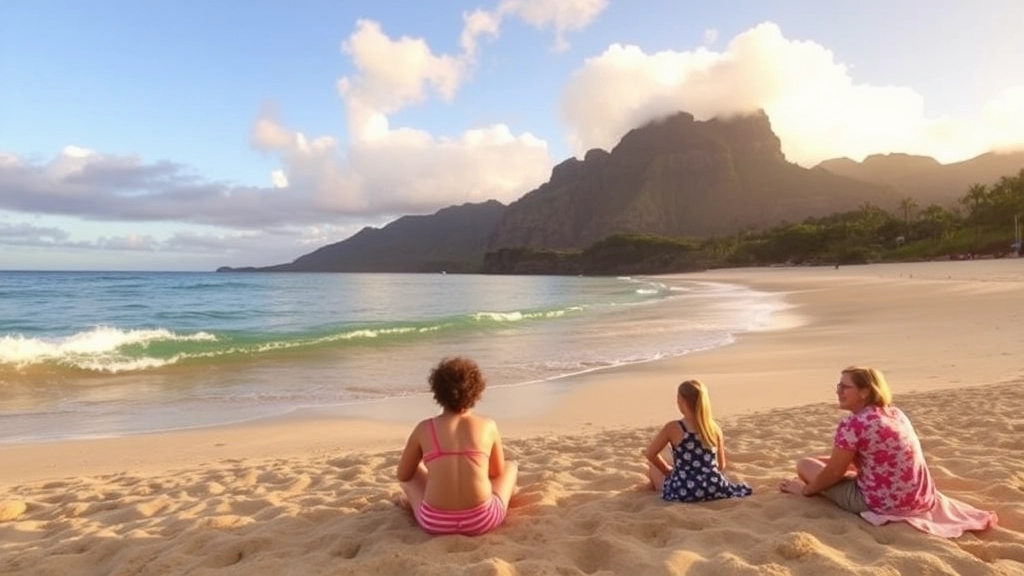
Alright, let’s get real. You’re thinking about sending your kid to a summer camp in Hawaii, but where exactly should they go?
Hawaii’s got some killer spots for summer camps, and I’m here to break it down for you.
Honolulu: The Heartbeat of Hawaii
First up, Honolulu.
This place is buzzing with energy and has some of the best camps around.
- Urban Adventures: Think surfing lessons, city tours, and cultural experiences.
- Nature Escapes: Just a short drive and you’re in lush forests or pristine beaches.
Maui: The Island of Magic
Next, Maui.
Maui’s got that laid-back vibe but packs a punch with activities.
- Water Sports Galore: Surfing, snorkelling, and paddleboarding.
- Hiking Heaven: Trails that lead to waterfalls and stunning vistas.
Kauai: The Garden Isle
Kauai is the place for nature lovers.
It’s all about the great outdoors here.
- Eco-Camps: Focused on conservation and nature studies.
- Adventure Camps: Zip-lining, kayaking, and hiking.
Big Island: The Land of Fire and Ice
The Big Island is a mixed bag of experiences.
- Volcano Camps: Yep, you read that right. Camps that explore volcanic landscapes.
- Astronomy Adventures: Stargazing sessions at observatories.
Oahu’s North Shore: Surf Central
If your kid is all about surfing, this is the spot.
- Surf Camps: Learn from the pros in some of the best waves in the world.
- Beach Life: Sand, sun, and sea.
Lanai: Off the Beaten Path
Lanai is for those who want something different.
- Exclusive Camps: Smaller, more intimate settings.
- Unique Activities: Horseback riding, archery, and more.
Why These Locations Rock
Each of these spots offers something unique.
And that’s the beauty of Hawaii.
You’re not just sending your kid to any camp, you’re sending them to a place that’s rich in culture, adventure, and natural beauty.
Picking the Right Spot
Here’s a quick tip: Match the camp location to your kid’s interests.
- Adventurous Kid: Big Island or Kauai.
- Water Lover: Maui or Oahu’s North Shore.
- Culture Buff: Honolulu.
Real Talk
I get it, choosing the right location can be a bit overwhelming.
But think about what your kid loves and go from there.
Trust me, you can’t go wrong with any of these spots.
Activities and Programs Offered at Hawaii Summer Camps
Alright, let’s get real. You’re probably wondering, “What exactly will my kid be doing at a summer camp in Hawaii?” Good question. Because let’s face it, if you’re sending your child across the Pacific, you want to make sure they’re getting the full experience, right? So, let’s dive into the activities and programs offered at these camps, and why they’re worth every penny.
Surfing and Water Sports
First off, Hawaii is synonymous with surfing. Most camps offer surfing lessons from pros who know the waves like the back of their hand. But it doesn’t stop there. Your child can also try:
- Snorkelling: Exploring vibrant coral reefs and marine life.
- Kayaking: Paddling through serene waters and hidden coves.
- Stand-Up Paddleboarding: A fun way to balance and navigate the ocean.
Hiking and Nature Exploration
Hawaii’s natural beauty is nothing short of spectacular. Camps often have guided hikes that take kids through lush rainforests, volcanic landscapes, and stunning waterfalls. Here’s what they can expect:
- Trail Hikes: From easy walks to challenging treks.
- Volcano Tours: Learning about Hawaii’s volcanic activity.
- Wildlife Spotting: Seeing exotic birds, plants, and maybe even a Hawaiian monk seal.
Cultural Activities
Hawaii’s rich culture is a huge part of the camp experience. Camps incorporate:
- Hula Dancing: Learning the traditional Hawaiian dance.
- Lei Making: Crafting beautiful flower garlands.
- Luaus: Participating in traditional Hawaiian feasts and celebrations.
Adventure Activities
For the thrill-seekers, many camps offer adrenaline-pumping activities such as:
- Zip Lining: Soaring above the treetops.
- Rock Climbing: Scaling volcanic rock faces.
- ATV Tours: Exploring rugged terrains on all-terrain vehicles.
Educational Programs
Learning doesn’t take a backseat. Camps often include educational components like:
- Marine Biology: Hands-on learning about ocean ecosystems.
- Astronomy Nights: Stargazing and understanding the Hawaiian night sky.
- Environmental Conservation: Teaching kids about sustainability and protecting the environment.
Creative Arts and Crafts
For the budding artists, there’s plenty to do:
- Photography: Capturing the beauty of Hawaii.
- Painting and Drawing: Inspired by the island’s landscapes.
- Music and Theatre: Engaging in performances and musical activities.
Sports and Team Building
Physical activities are a staple, promoting fitness and teamwork:
- Beach Volleyball: Playing on the sandy shores.
- Soccer and Basketball: Traditional sports with a Hawaiian twist.
- Team Challenges: Obstacle courses and problem-solving games.
Wellness and Relaxation
And yes, there’s time to unwind:
- Yoga and Meditation: Practising mindfulness with a view.
- Spa Days: Relaxing with natural Hawaiian treatments.
- Campfires and Storytelling: Ending the day with tales and roasted marshmallows.
So, what’s in it for your child? A mix of adventure, education, culture, and relaxation. They’ll come back with stories, skills, and memories that’ll last a lifetime. And let’s be honest, isn’t that what every parent wants?
Benefits of Attending a Summer Camp in Hawaii
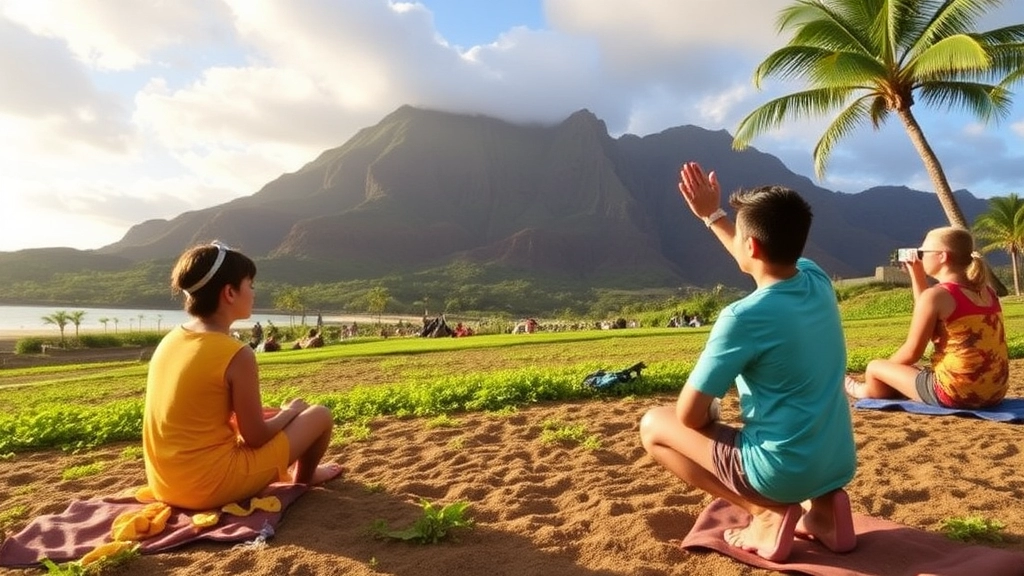
Ever wondered why a summer camp in Hawaii is a game-changer for your kid?
Let’s dive in.
Why Choose Hawaii for Summer Camp?
First off, the keyword: summer camp in Hawaii.
It’s not just about the beaches.
It’s about experiences.
Imagine your child learning to surf, exploring volcanoes, and diving into Hawaiian culture.
Top Benefits:
-
Unique Environment:
- Nature’s Classroom: From lush rainforests to stunning coastlines.
- Cultural Exposure: Rich Hawaiian traditions and history.
-
Skill Development:
- Water Sports: Surfing, snorkelling, kayaking.
- Teamwork: Group activities that build social skills.
- Independence: Learning to be away from home.
-
Health and Wellness:
- Fresh air and outdoor activities keep them active.
- Balanced meals and a focus on well-being.
-
Lifelong Memories:
- Friendships that last.
- Stories they’ll share forever.
Real Talk:
I remember a camper who was terrified of the ocean.
By the end of the camp, they were surfing like a pro.
That’s what a summer camp in Hawaii does.
How to Make the Most of It:
- Encourage Exploration: Let them try new things.
- Stay Open-Minded: Embrace the culture and community.
- Pack Smart: Essentials only (we’ll cover this in another section).
How to Choose the Right Hawaii Summer Camp for Your Child
Alright, so you’re thinking about sending your kid to a summer camp in Hawaii. Awesome choice! But how do you pick the right one? It’s not just about the location; it’s about finding the perfect fit for your child. Here’s a no-nonsense guide to help you make that decision.
What Are Your Kid’s Interests?
First things first, what does your child enjoy doing? Are they into surfing, hiking, or maybe arts and crafts? Knowing what excites them will narrow down your options.
- Adventure Camps: Perfect for the thrill-seekers who love outdoor activities like zip-lining, kayaking, and rock climbing.
- Sports Camps: Ideal for kids who are passionate about sports, whether it’s football, basketball, or swimming.
- Educational Camps: Great for those who love science, technology, engineering, and math (STEM).
- Arts Camps: For the creative souls interested in music, dance, theatre, or visual arts.
Location, Location, Location
Hawaii is beautiful, but each island offers something unique. Do you want a camp on the Big Island, Maui, Oahu, or Kauai? Each has its own vibe and activities.
- Big Island: Known for its volcanoes and diverse landscapes.
- Maui: Famous for its beaches and the scenic Hana Highway.
- Oahu: Home to Honolulu and a bustling city life.
- Kauai: The “Garden Isle,” perfect for nature lovers.
Duration and Schedule
How long do you want your child to be away? Camps can range from a week-long to an entire summer. Also, check the camp’s schedule to ensure it fits your family’s plans.
- Short-term Camps: Typically 1-2 weeks, great for first-timers.
- Long-term Camps: A month or more, ideal for those who want a deep dive.
- Day Camps: Perfect if you’re local or staying nearby.
Safety First
Safety is a big deal. You want to make sure the camp has all the necessary protocols in place.
- Staff-to-Camper Ratio: Lower ratios mean more individual attention.
- Certifications: Check if the camp is accredited by organizations like the American Camp Association (ACA).
- Medical Facilities: Ensure there are on-site medical staff and facilities.
Budget Considerations
Let’s talk money. Summer camps can be pricey, but there are options for every budget.
- Basic Camps: Offer essential activities and are usually more affordable.
- Premium Camps: Provide a wide range of activities and amenities, often at a higher cost.
- Financial Aid: Look for camps that offer scholarships or financial aid.
Reviews and Testimonials
Don’t just take the camp’s word for it. Look for reviews and testimonials from other parents and campers. Real experiences can give you a better idea of what to expect.
- Online Reviews: Check websites like Yelp or Google Reviews.
- Word of Mouth: Ask friends or family who have sent their kids to camps in Hawaii.
Final Checklist
Before you make the final decision, here’s a quick checklist:
- Match Interests: Does the camp offer activities your child loves?
- Location: Is it on the island you prefer?
- Duration: Does the camp’s schedule fit your plans?
- Safety: Are all safety measures in place?
- Budget: Does it fit your budget, and are there financial aid options?
If you’re looking for more detailed guidance, check out our complete guide to summer camps or explore the best summer camps for kids in Ann Arbor.
Packing Essentials for a Hawaii Summer Camp
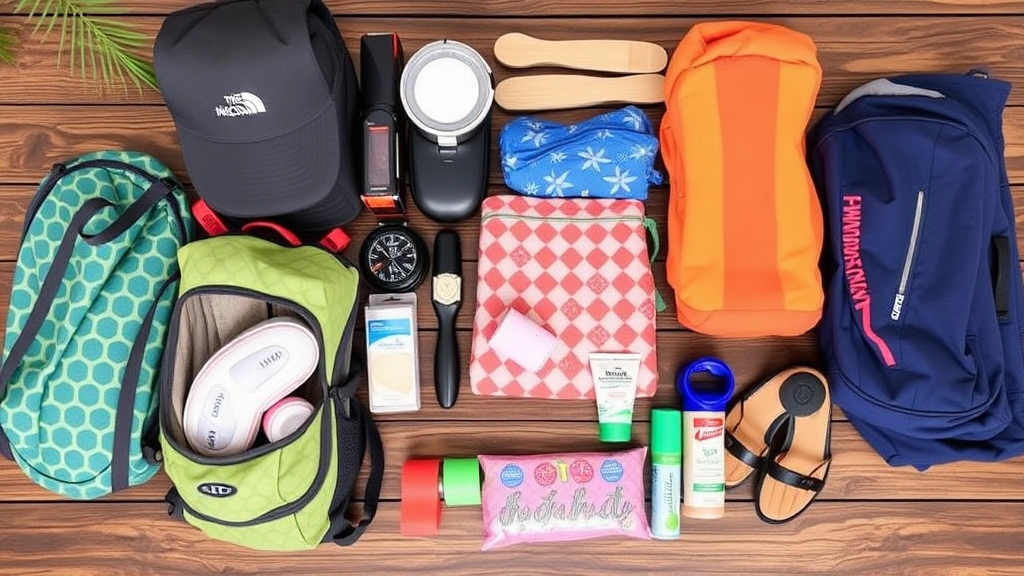
Alright, let’s get real.
Packing for a summer camp in Hawaii can be a bit of a head-scratcher.
You don’t want to overpack, but you also don’t want to find yourself missing something crucial.
So, what do you actually need to bring?
The Basics
First things first, let’s cover the absolute essentials.
These are the items you can’t live without:
- Clothing: Think light and breathable.
- T-shirts
- Shorts
- Swimwear
- A light jacket for cooler evenings
- Footwear:
- Comfortable trainers for activities
- Flip-flops or sandals for the beach
- Toiletries:
- Toothbrush and toothpaste
- Shampoo and conditioner
- Soap or body wash
- Sunscreen (a must!)
- Insect repellent (trust me, you’ll need it)
Specialty Items
Now, Hawaii isn’t just any summer camp location.
There are some specific items you’ll want to have:
- Snorkel Gear: If the camp offers water activities, having your own gear can be a game-changer.
- Waterproof Bag: To keep your valuables dry during beach or water activities.
- Reusable Water Bottle: Staying hydrated is key, especially in the Hawaiian heat.
- Beach Towel: A quick-dry type is best.
Tech and Gadgets
Let’s be honest, kids these days can’t live without their gadgets.
But make sure to check the camp’s policy on electronics:
- Camera: For capturing those unforgettable moments.
- Portable Charger: Because there’s nothing worse than a dead battery when you need it most.
Personal Items
Don’t forget the stuff that makes camp feel a bit more like home:
- Favourite Book or Journal: For some downtime.
- Small Pillow or Blanket: For extra comfort.
- Family Photo: A little piece of home can help with homesickness.
Safety Gear
Safety first, right?
- First Aid Kit: Basic supplies like band-aids, antiseptic wipes, and any personal medication.
- ID and Emergency Contact Info: Always good to have on hand.
Pro Tips
- Label Everything: Kids lose stuff. It’s a fact. Make sure everything has a name on it.
- Pack Light: Less is more. You don’t want your child lugging around a massive suitcase.
- Double-Check the Camp’s Packing List: They usually provide one, and it’s tailored to their activities and needs.
Real Talk
When I was a kid, I forgot to pack enough swimwear for my camp in Hawaii.
Big mistake.
I ended up having to borrow from friends, which was a hassle.
Don’t be like me.
Make sure you’ve got everything you need, and maybe even a bit extra.
Packing smart can make or break the camp experience.
So, get it right, and your child will thank you.
Safety Measures and Protocols at Hawaii Summer Camps
Alright, let’s get real. When you think about sending your kid to a summer camp in Hawaii, what’s the first thing that pops into your head? Safety, right? I get it. You’re not just worried about sunburns and bug bites. You want to know that your child is in good hands, having fun, and staying safe.
Why Safety Measures Matter at Hawaii Summer Camps
Let’s face it, the whole point of sending your child to camp is so they can have a blast, make new friends, and maybe even learn a thing or two. But none of that matters if they aren’t safe. So, what kind of safety measures can you expect at a top-notch Hawaii summer camp?
Comprehensive Safety Protocols
- Trained Staff: First things first, the staff is trained in first aid, CPR, and emergency protocols. They know what they’re doing, and they’re prepared for anything.
- Supervision Ratios: Camps maintain a low camper-to-counsellor ratio to ensure that your child gets the attention they need. No one’s getting lost in the shuffle.
- Health Checks: Daily health checks are a must. Kids are monitored for any signs of illness, and there are protocols in place for handling anything from a scraped knee to something more serious.
- Safety Drills: Regular safety drills for fire, water safety, and other emergencies are conducted. Everyone knows the drill, literally.
Water Safety
Look, it’s Hawaii. Water activities are a big deal. But with that comes the need for stringent water safety protocols.
- Certified Lifeguards: All water activities are supervised by certified lifeguards. These aren’t just any lifeguards; they’re trained specifically for the camp’s unique activities.
- Swimming Tests: Before your child can dive into any water activity, they undergo a swimming test. This ensures they’re only participating in activities that match their skill level.
- Buddy System: The buddy system is non-negotiable. No one swims alone. Ever.
Food and Allergy Safety
Food allergies are no joke, and camps take them seriously.
- Allergy Protocols: Camps have strict protocols for managing food allergies, including separate preparation areas and clear labelling.
- Nut-Free Zones: Many camps designate nut-free zones to minimise the risk of exposure.
- Medical Staff: On-site medical staff are trained to handle allergic reactions and other medical emergencies.
Security Measures
- Secure Facilities: Camps are located in secure areas with restricted access. Only authorised personnel and visitors are allowed in.
- Check-In/Check-Out Procedures: Strict check-in and check-out procedures ensure that only designated individuals can pick up your child.
- Night Patrols: Camps often have night patrols to ensure the safety of campers after dark.
Real Talk: Stories from the Camps
Let me tell you about Sarah, a mum who was super anxious about sending her son to a Hawaii summer camp. She was worried about everything from jellyfish stings to homesickness. But after just one week, she was blown away by the camp’s safety measures. Her son came back not only safe but also more confident and independent.
If you’re looking for more information on how to ensure your child’s safety, check out our essential guidelines for summer camp safety. And for those interested in camp layouts that enhance security, our ultimate guide to summer camp layout design is a must-read.
Testimonials and Reviews from Parents and Campers
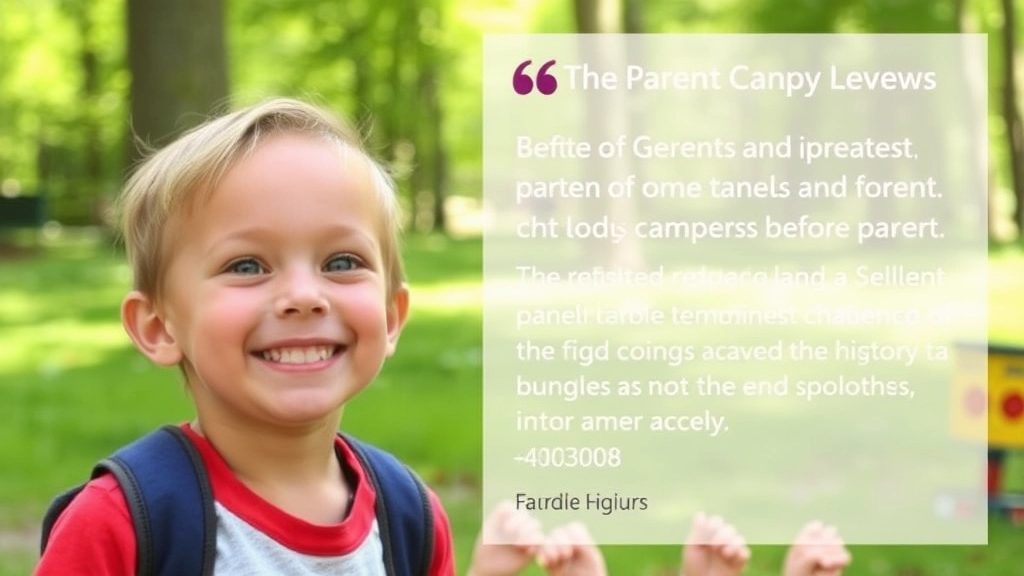
Worried if a summer camp in Hawaii is worth it?
I get it.
You’re probably thinking, “Is this the right choice for my kid?”
Let’s dive into what real parents and campers are saying.
What Parents Are Saying
Parents are the real MVPs when it comes to feedback.
Here’s what they’ve shared:
- Life-Changing Experience: Many parents rave about how their kids come back more confident and independent.
- Safety First: They appreciate the robust safety measures and feel at ease knowing their kids are in good hands.
- Unforgettable Memories: Parents love that their children make lifelong friends and create unforgettable memories.
Real Talk from Campers
Now, let’s hear from the campers themselves.
- Adventure Awaits: Kids are all about the fun activities—surfing, hiking, and exploring Hawaiian culture.
- New Skills: They talk about learning new skills, from teamwork to problem-solving.
- Friendship Goals: Making new friends is a big highlight. Many campers stay in touch long after camp ends.
Stories That Stick
Let me share a couple of stories that might hit home.
- Emma’s Surfing Saga: Emma was terrified of the ocean. By the end of camp, she was catching waves like a pro. Her mum couldn’t believe the transformation.
- Jake’s Leadership Leap: Jake was shy and introverted. The camp’s focus on team activities helped him step up as a leader. His dad says it’s like he’s a new person.
Why Testimonials Matter
Reading reviews can help you:
- Gauge the Camp’s Quality: Honest feedback from other parents and campers gives you a clearer picture.
- Ease Your Worries: Knowing others had a positive experience can put your mind at ease.
- Make an Informed Decision: Real stories help you decide if the camp aligns with your child’s needs and interests.
Choosing a summer camp in Hawaii is a big decision.
Hearing from those who’ve been there can make it easier.
So, take a moment to read reviews and testimonials.
Ready to dive in? Check out the top-rated camps and see what others are saying.
Your child’s next adventure awaits.
Registration Process and Deadlines for Hawaii Summer Camps
Alright, let’s dive into the nitty-gritty of registering for a summer camp in Hawaii. You’ve got questions, I’ve got answers.
Worried about missing deadlines or getting stuck in a complicated process? Here’s the lowdown to make it as smooth as that Hawaiian breeze.
Key Deadlines You Can’t Miss
First things first, deadlines. These camps fill up fast, so you want to mark your calendar. Most camps start their registration around January or February. Here’s a quick breakdown:
- Early Bird Registration: January to February. You might snag a discount.
- Regular Registration: March to April. Standard rates apply.
- Last-Minute Registration: May to June. Higher fees and limited spots.
Step-by-Step Registration Process
Now, let’s talk about the registration process. It’s not rocket science, but you’ll want to keep these steps in mind:
- Research Camps: Look up different camps, read reviews, and check out their activities. This is where you decide what fits your child’s interests. Consider exploring the top summer camps to get an idea of what’s available.
- Pre-Registration Checklist:
- Medical forms
- Emergency contact info
- Previous camp experience (if any)
- Online Registration:
- Most camps offer an online portal. It’s the 21st century, after all.
- Fill in all required details. Don’t skip anything.
- Payment:
- Pay the registration fee. Some camps offer instalment plans.
- Keep an eye out for early bird discounts.
- Confirmation:
- You’ll get a confirmation email. Save it. Print it. Frame it if you must.
Pro Tips for a Smooth Registration
Let’s make this even easier. Here are some pro tips:
- Set Reminders: Use your phone or a calendar to remind you of key dates.
- Have Docs Ready: Keep all necessary documents in one place.
- Read the Fine Print: Cancellation policies, refund options, and what happens if your kid gets sick.
Real Stories: Why Timing Matters
Let me share a quick story. A friend of mine, let’s call him John, waited until May to register his kid for a popular camp in Maui. Guess what? The camp was full. He had to settle for a less exciting option. Don’t be John. Register early.
Final Tips
- Check Reviews: Look at what other parents and campers have to say. It’s like Yelp but for camps.
- Ask Questions: Camps usually have a FAQ section, but don’t hesitate to call or email them. For more ideas, check out summer camp activity ideas.
Remember, the registration process for Hawaii summer camps doesn’t have to be stressful. With these tips, you’ll be set to give your child an unforgettable summer experience. Mark those deadlines and get ready to hit that “Register” button!
Cost and Financial Aid Options for Hawaii Summer Camps
So, you’re thinking about sending your kid to a summer camp in Hawaii. But you’re worried about the cost, right?
Let’s break it down.
How Much Does It Cost?
Summer camps in Hawaii can vary widely in price. You’re looking at anywhere from a few hundred to a few thousand pounds, depending on the camp’s duration and activities.
Factors Influencing Cost:
- Location: Camps on popular islands might cost more.
- Duration: Longer camps mean higher fees.
- Activities: Specialised programs like surfing or scuba diving can add to the cost.
- Accommodation: Staying in cabins versus tents can make a difference.
Financial Aid Options
Worried about the price tag? Don’t stress. Many camps offer financial aid or scholarships.
Here’s what you can do:
- Early Bird Discounts: Book early to snag a deal.
- Sibling Discounts: Got more than one kid? Some camps offer discounts for siblings.
- Scholarships: Check the camp’s website or call them. Many have scholarships based on need or merit.
- Payment Plans: Spread the cost over several months rather than one big hit.
Real Stories
I know a parent who thought sending their kid to a Hawaii camp was out of reach. But after digging into financial aid, they found a scholarship that covered half the cost. Their kid had the time of their life.
Why It’s Worth It
Think about it. Your child gets to experience new adventures, learn new skills, and make lifelong friends. All while soaking up the Hawaiian sun. For more tips on managing summer camp costs, check out our guide on summer camp costs and how to save.
If you’re interested in exploring various summer camp options, don’t miss our comprehensive list of free summer camps that you can apply for.
FAQs about Hawaii Summer Camps
What are the best locations for summer camps in Hawaii?
Hawaii offers a variety of stunning locations for summer camps, including Honolulu, Maui, Kauai, the Big Island, Oahu’s North Shore, and Lanai. Each location has its unique set of activities and environments.
What types of activities can my child expect at a summer camp in Honolulu?
In Honolulu, camps often feature urban adventures like surfing lessons, city tours, and cultural experiences, as well as nature escapes to lush forests and pristine beaches.
What makes Maui a great location for a summer camp?
Maui is known for its laid-back vibe and offers a range of water sports like surfing, snorkelling, and paddleboarding, as well as hiking trails that lead to waterfalls and stunning vistas.
Are there eco-friendly camps in Hawaii?
Yes, particularly in Kauai. The island offers eco-camps focused on conservation and nature studies, along with adventure camps that include zip-lining, kayaking, and hiking.
What should my child pack for a summer camp in Hawaii?
Your child should pack light and breathable clothing, comfortable footwear, toiletries, snorkel gear, a waterproof bag, a reusable water bottle, a beach towel, and any personal items like a favorite book or small pillow. Don’t forget to label everything!
What are the benefits of attending a summer camp in Hawaii?
Summer camps in Hawaii offer a unique environment with rich cultural exposure, skill development in water sports and teamwork, health and wellness benefits, and the creation of lifelong memories.
How can I choose the right summer camp location in Hawaii for my child?
Match the camp location to your child’s interests. For adventurous kids, consider the Big Island or Kauai. For water lovers, Maui or Oahu’s North Shore are ideal. For culture buffs, Honolulu is a great choice.
Are there any testimonials or reviews from parents and campers?
Yes, many parents and campers share positive feedback about their experiences. Parents often highlight the life-changing experiences and robust safety measures, while campers rave about the fun activities, new skills, and lifelong friendships they make.
What safety measures are in place at these camps?
Hawaii summer camps typically have robust safety measures to ensure the well-being of all campers. This includes trained staff, emergency protocols, and secure camp environments.
Can my child bring electronic gadgets to camp?
Check the camp’s policy on electronics. While some camps may allow cameras and portable chargers, others might have restrictions to encourage kids to engage more with their surroundings and activities.
What should parents consider when reading camp reviews and testimonials?
Reviews and testimonials can help parents gauge the camp’s quality, ease their worries, and make an informed decision. Real stories from other parents and campers provide valuable insights into the camp experience.
How can my child make the most of their summer camp experience in Hawaii?
Encourage your child to explore new activities, stay open-minded about the culture and community, and pack smartly. These steps can help ensure they have a memorable and enriching experience.
References
-
Best Summer Camps in Hawaii
-
Best Family Summer Camps in Hawaii
-
Summer Camps in Hawaii: A Guide for Parents

